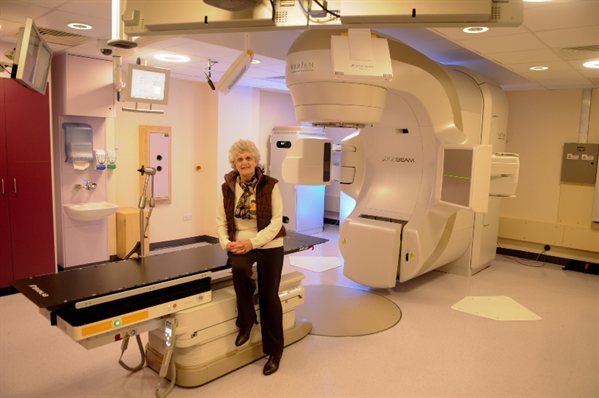First patient receives treatment on new radiotherapy machine

Glynis Albrighton, the first patient to receive treatment on the new machine pictured with her oncology consultant Dr Qurrat Mehmood
Patients receiving radiotherapy treatment at Northampton General Hospital are benefitting from the first phase of a £5.5 million programme to upgrade its linear accelerator cancer machines.
The first linear accelerator (LINAC) machine to be installed as part of the replacement programme has treated its first patient, Glynis Albrighton, who said: “I didn’t know what to expect to be honest, but as soon as I came in, everyone was so comforting explaining everything to me, showing me the machine, explaining what would happen and what the aftereffects would be. I felt very confident in everybody.”
The new machine is housed in a purpose-designed converted building connected to the main hospital site by a new glass walkway.

Mrs Albrighton pictured in the new treatment room
Consultant oncologist Dr Craig Knighton said: “With our three existing LINAC machines all coming to end of their life at the same time and needing to be replaced, the timing was perfect for us to look at the bigger picture to see how we could improve the overall experience of our radiotherapy patients. “With the three new machines, Northampton will be one of the most advanced centres for radiotherapy in the country, with benefits including a greater range of therapies, reduced side effects and improved positioning of patients which means better accuracy in targeting cancer cells.”Dr Qurrat Mehmood, consultant clinical oncologist and Mrs Albrighton’s consultant said: “This machine gives superior imaging with the facility of CT scanning and that gives the detail in making sure the treatment that you’ve planned and designed for the patient is actually the treatment that’s being delivered with regard to the accuracy.“Our patients will benefit from having the reassurance that we’re doing more targeted treatments which should result in better cure rates but also that we’ll be able to lower the long and short term side effects to tissue that doesn’t need radiotherapy.”A linear accelerator (LINAC) is the device most commonly used for external beam radiation treatments for patients with cancer. The linear accelerator is used to treat all parts of the body by delivering high-energy x-rays to the region of the patient's tumour.Watch a
short video featuring Mrs Albrighton talking abouther experience.
Posted on Tuesday 15th December 2015